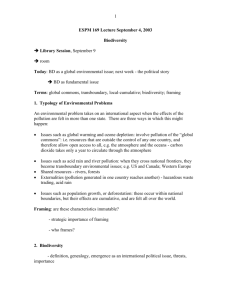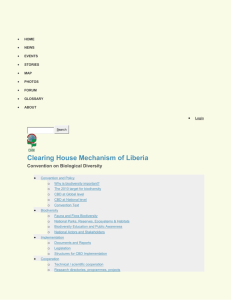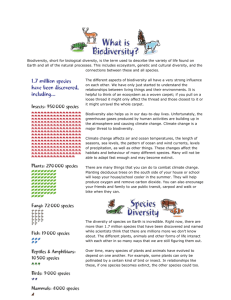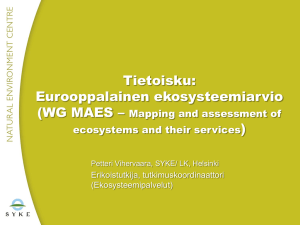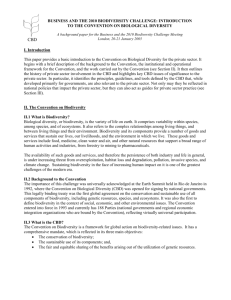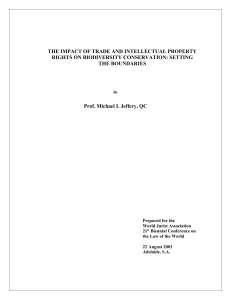September 12 - What is Biodiversity?
advertisement
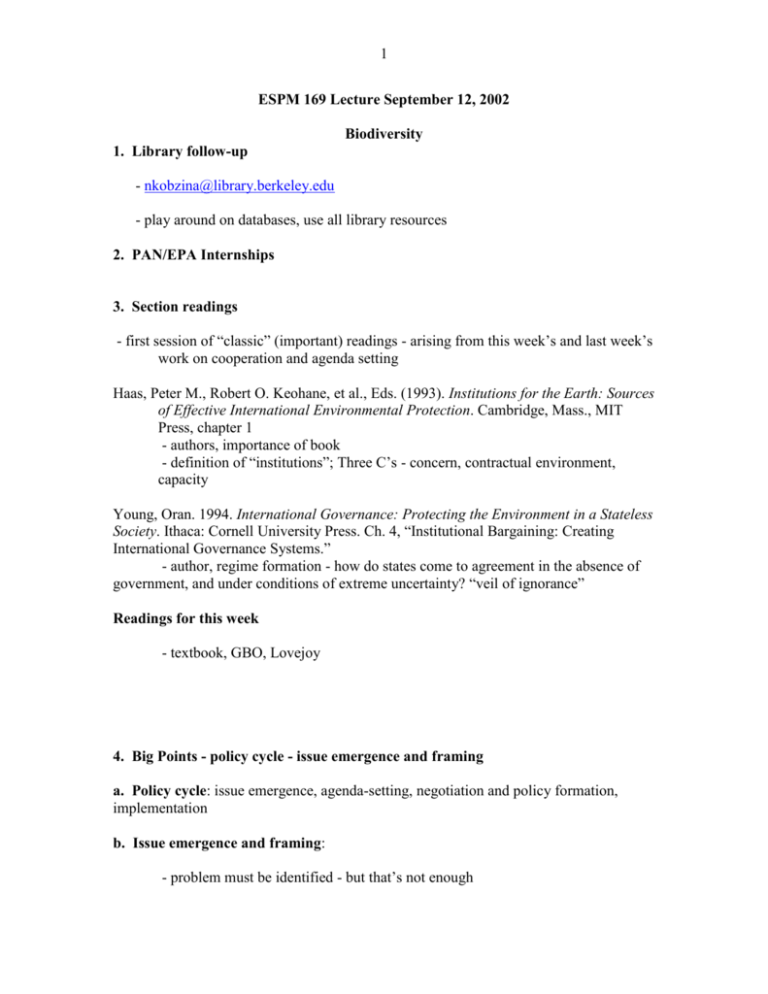
1 ESPM 169 Lecture September 12, 2002 Biodiversity 1. Library follow-up - nkobzina@library.berkeley.edu - play around on databases, use all library resources 2. PAN/EPA Internships 3. Section readings - first session of “classic” (important) readings - arising from this week’s and last week’s work on cooperation and agenda setting Haas, Peter M., Robert O. Keohane, et al., Eds. (1993). Institutions for the Earth: Sources of Effective International Environmental Protection. Cambridge, Mass., MIT Press, chapter 1 - authors, importance of book - definition of “institutions”; Three C’s - concern, contractual environment, capacity Young, Oran. 1994. International Governance: Protecting the Environment in a Stateless Society. Ithaca: Cornell University Press. Ch. 4, “Institutional Bargaining: Creating International Governance Systems.” - author, regime formation - how do states come to agreement in the absence of government, and under conditions of extreme uncertainty? “veil of ignorance” Readings for this week - textbook, GBO, Lovejoy 4. Big Points - policy cycle - issue emergence and framing a. Policy cycle: issue emergence, agenda-setting, negotiation and policy formation, implementation b. Issue emergence and framing: - problem must be identified - but that’s not enough 2 - consensus must emerge that it needs to be addressed internationally (that national action is not enough) - framing: very important in this process - issue sponsors (e.g. UNEP, IUCN, conservation biologists) put the issue in such a way that stresses its importance, its global nature, and that point towards a manageable set of policy tools - raises concern, capture imaginations - social and political process - as much about communication as anything c. Causes and Policy Options: fundamental cf. proximate; fixed vs. malleable example: democracies and war 5. Biodiversity - definition, genealogy, emergence as an international political issue, threats, importance a. Definitions Write down important elements of biodiversity Convention Definition: “all aspects of variability evident within the living world, including diversity within and between individuals, populations, species, communities and ecosystems….the term is commonly used loosely to refer to all species and habitats in some given area or the earth overall” “Biological diversity incorporates the idea of distinctiveness at every level of life from molecules to cells, to individuals, to species, to assemblages of species and to ecosystems” (Murray, 1995:19) b. Genealogy of Term conservation (wildlife, natural variety, fellow creatures, preservation of endangered species) to biological diversity to biodiversity - a rallying cry - important part of framing process contains aspects of genetic diversity and habitat (in-situ conservation) that are different from 19th century conceptions 3 Takacs: role of conservation biologists (a discipline founded in 1980s out of ecology and evolutionary biology - mission - to conserve biological diversity - specific writers - Leopold, Carson, Paul and Anne Ehrlich - founding of the National Forum on BioDiversity sponsored by NAS in mid 1980s in US - Walter G. Rosen (senior program officer for Board of Basic Biology) is credited with the term: "take the logical out of biological" - i.e. inject emotion; EO Wilson et al involved early - - - the right buzzword at the right time - unified a bunch of scientific approaches, linked in with "cultural diversity" and humanity (not just wilderness or animals) - diversity seen as a normative good shift from defense to offense popular internationally though "biological diversity" still used officially c. Levels of BD: 1. Genetic - most basic building-block of BD: blueprint for individual organisms 2. Species (most useful measure) - distinctive groups of similar populations that are isolated reproductively from other such groups 3. Ecosystems 4. All add up to the biosphere - through which BD is distributed - hot-spots; tropics - also a framing issue for international action Genetic BD: important because genetic diversity ensures survival in changing conditions - wild genes in grain production - loss of genetic diversity in threatened populations - biotechnology first point of serious controversy in case - textbook cf. UN document we have always manipulated genetic diversity, but at an organism level - interbreeding animal species and plant species. In the 1990s, techniques have emerged to engineer genes themselves - producing GMOs - using genes from entirely different organisms 4 strong arguments as to whether it will destroy BD or save us Species BD: historically, the main framing of the problem - easy to measure, map and demonstrate - 1.75 million plant and animal species have been identified; possibly many millions more - extinction: does occur naturally, but rate has been much higher; around 300-350 species of vertebrates, 400 invertebrates in the last 400 years; higher number of plant species. - threatened species: 24% of mammal species and 12% of birds considered threatened with extinction in 2000. Ecosystems (Habitats): - marine and coastal - freshwater - forests - dry and sub-humid land ecosystems - agricultural ecosystems d. Value of BD again, an important part of the framing process a basic issue: underlies the continuation of life on earth - see Lovejoy piece - aesthetic and ethical: charismatic macrofauna - economic - food, medicine are most commonly cited - agriculture, water, fish - most important source of protein for a lot of the world; water a source of energy, too. - tourism - ecological - natural services - cleansing (dispersal and breakdown of wastes), climate regulation, protection from erosion, pollination - especially bacteria, and other lower forms of life e. Threats to BD write down threats! 5 - proximate and fundamental - anthropogenic threats - again, framing - habitat conversion, fragmentation, destruction (desertification, salinization) - in particular, forest loss, development of wetlands and swamps - 1980: 113,000 km2 of tropical forest was cleared, up to 169,000 in 1990 - invasive, introduced species (rabbits in Australia as e.g. of both!) - climate change - chemical pollution - waste, acid rain, oil spills - nitrogen deposition from fertilizers, fossil fuel burning (algae blooms) - population growth - consumption f. Links to International Action - monitoring and cataloging - system-level effects - global dependence on resources in different parts of the world - “stewardship” arguments - shared problems - crises - e.g. Lake Victoria (Kenya, Tanzania, Uganda) Finally: issues for next time! moving on to agenda setting and policy-making - how the international community first started thinking about a convention what were the early issues/actors/obstacles that came up? Readings Week 4 September 17 - Issue Emergence and Early Negotiations * Porter, Brown and Chasek, pp. 124-130 * Guruswamy and McNeely, pp. 168-179 ("Halting the Loss of Biodiversity: International Institutional Measures", by Walter V. Reid) * **Chasek, Pamela S. (2001). Earth Negotiations: Analyzing Thirty Years of Environmental Diplomacy. Tokyo, United Nations University Press, pp. 116-124 (Case Study on the CBD) * **Koester, Veit (2002). "The Five Global Biodiversity-Related Conventions: A Stocktaking." Review of European Community & international environmental law: 6 RECIEL 11(1): 96-103. Available online for UCB Library patrons (show me, scroll down, it's No. 10) September 19 - The Convention on Biological Diversity * Guruswamy and McNeely, pp. 393-413 - Full Text of the CBD (also at www.biodiv.org/convention/articles.asp) * Guruswamy and McNeely, pp. 351-359 ("The CBD: A Polemic") * **McGraw, Désirée M. (2002). "The CBD - Key Characteristics and Implications for Implementation." Review of European Community & international environmental law: RECIEL 11(1): 17-28. Available online for UCB Library patrons (show me, scroll down, it's No. 3) * TASK: Explore the CBD website, www.biodiv.org to look at Convention signatories, associated bodies, and other aspects of Convention organization
